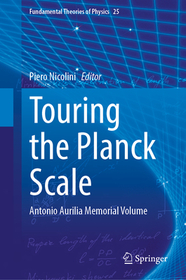
Touring the Planck Scale
Antonio Aurilia Memorial Volume
Sorozatcím: Fundamental Theories of Physics; 219;
-
20% KEDVEZMÉNY?
- A kedvezmény csak az 'Értesítés a kedvenc témákról' hírlevelünk címzettjeinek rendeléseire érvényes.
- Kiadói listaár EUR 106.99
-
44 374 Ft (42 261 Ft + 5% áfa)
Az ár azért becsült, mert a rendelés pillanatában nem lehet pontosan tudni, hogy a beérkezéskor milyen lesz a forint árfolyama az adott termék eredeti devizájához képest. Ha a forint romlana, kissé többet, ha javulna, kissé kevesebbet kell majd fizetnie.
- Kedvezmény(ek) 20% (cc. 8 875 Ft off)
- Kedvezményes ár 35 499 Ft (33 809 Ft + 5% áfa)
- A kedvezmény érvényes eddig: 2025. december 31.
Iratkozzon fel most és részesüljön kedvezőbb árainkból!
Feliratkozom
44 374 Ft

Beszerezhetőség
Megrendelésre a kiadó utánnyomja a könyvet. Rendelhető, de a szokásosnál kicsit lassabban érkezik meg.
Why don't you give exact delivery time?
A beszerzés időigényét az eddigi tapasztalatokra alapozva adjuk meg. Azért becsült, mert a terméket külföldről hozzuk be, így a kiadó kiszolgálásának pillanatnyi gyorsaságától is függ. A megadottnál gyorsabb és lassabb szállítás is elképzelhető, de mindent megteszünk, hogy Ön a lehető leghamarabb jusson hozzá a termékhez.
A termék adatai:
- Kiadás sorszáma 2025
- Kiadó Springer Nature Switzerland
- Megjelenés dátuma 2025. augusztus 22.
- Kötetek száma 1 pieces, Book
- ISBN 9783031760655
- Kötéstípus Keménykötés
- Terjedelem280 oldal
- Méret 235x155 mm
- Nyelv angol
- Illusztrációk XIV, 280 p. 63 illus., 40 illus. in color. Illustrations, black & white 689
Kategóriák
Hosszú leírás:
This book in honor of Antonio Aurilia provides an overview of one of the most mysterious research fields in theoretical physics, namely the fundamental interactions at energies between the electroweak scale and the Planck scale. The latter includes physics beyond the Standard Model, strings and p-branes, quantum gravity, quantum black holes and early Universe cosmology. A related goal of the work is to present the physical conditions upon which some piece of evidence of new physics at extreme energies can be exposed at current (or near future) experimental facilities. The work is organized in three parts. The first part schematically introduces the problem of fundamental interactions and summarizes the life and work of Prof. Aurilia. The second part forms the body of the book. It contains contributions from internationally recognized specialists who collaborated with Prof. Aurilia, such as R. Balbinot, B. Carr, G. Dvali, A. Fabbri, P. Gaete, J. A. Helayël-Neto, R. Mann, J. Mureika, D. Singleton, A. Smailagic, E. Spallucci and P. Townsend. The third part summarizes the work and draws the conclusions with particular attention to future developments.
TöbbTartalomjegyzék:
Introduction.- The issue of fundamental interactions.- Life and work of Antonio Aurilia.- The Physics from the electroweak to the Planck scale.- Particle sectors beyond the Standard Model.- Noncommutative and nonlocal quantum field theory.- Supergravity, superstrings and quantum gravity.- Evaporating black holes and black hole thermodynamics.- Quantum pregeometry and Planckian black holes.- Analogue gravity systems.- Higher dimensional spacetimes and terascale quantum gravity.- Dimensionally reduced Universe and Planck time cosmology.- Future perspectives.- Summary of the proposed results and potential developments.- Experimental observations in the near future.- Final remarks and conclusions.






